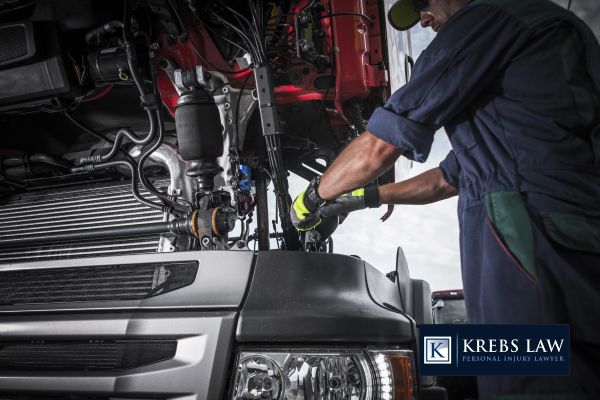This page was written, edited, reviewed & approved by JR Krebs following our comprehensive editorial guidelines. JR Krebs, the Founding Partner, has years of legal experience as a bankruptcy attorney. Our last modified date shows when this page was last reviewed.

When a commercial truck crashes, the damage is often serious. These trucks are large, heavy, and hard to stop. That’s why they are held to higher safety standards than regular vehicles. To keep roads safe, the federal government has created strict trucking rules that every company and driver must follow.
At Krebs Law Personal Injury Lawyers, we help victims hurt in accidents involving commercial motor vehicles. Many of these crashes happen because someone failed to follow federal safety regulations. Knowing the rules that apply to the motor carrier, the driver, and the truck itself can help you understand your rights.
If a violation led to your injury, you may be able to hold the motor carrier accountable and recover financial compensation. Our team uses these rules every day to build strong cases for truck accident victims and their families.
The trucking industry is regulated at the federal level to make sure all motor carriers and commercial vehicles meet safety standards across state lines. These regulations are designed to reduce crashes and protect everyone on the road.
Any company that operates trucks across state lines must follow rules set by the Federal Motor Carrier Safety Administration (FMCSA). These rules apply to both the truck and the driver. They also apply to the company that owns or manages the motor carrier operations. The federal government created these rules to stop unsafe drivers, fix poor truck maintenance, and limit long hours that lead to driver fatigue.
Even if a trucking company only sends trucks into another state once in a while, it must still follow these rules. If they don’t, they can face fines, license suspension, and lawsuits if someone gets hurt in a crash caused by non-compliance.
The Federal Motor Carrier Safety Administration (FMCSA) is the main government agency responsible for overseeing motor carrier operations across the United States. It was created to improve safety in the trucking industry and reduce the number of crashes involving commercial motor vehicles. The FMCSA sets national safety regulations that trucking companies and drivers must follow when operating across state lines.
This agency focuses on many areas of compliance, including the number of hours a driver can stay on the road, vehicle inspection rules, and drug and alcohol testing programs. The FMCSA also monitors companies for violations and can issue penalties or shut down unsafe operations. Its authority covers all trucks and buses that transport goods or passengers in interstate commerce. By holding both companies and drivers accountable, the FMCSA plays a critical role in protecting the general public from the dangers of unsafe motor vehicles on the road.
The purpose of the FMCSA regulations is to make sure that every motor carrier and commercial motor vehicle that crosses state lines is operating as safely as possible to protect both drivers and the general public. These rules are meant to reduce crashes, injuries, and deaths involving large trucks and buses by setting clear and enforceable safety standards for the entire industry.
By creating strict guidelines for driver qualifications, truck maintenance, working hours, and the handling of hazardous materials, the FMCSA helps prevent dangerous conditions that can lead to deadly accidents.
The rules also require trucking companies to track driver activity, keep proper records, and ensure that their vehicles are in good working condition before being sent out on the road. Overall, these regulations are in place to promote safety and ensure that companies remain in full compliance with federal laws designed to reduce the risks of motor carrier operations.
The FMCSA regulations apply to all commercial motor vehicles and drivers that are involved in interstate commerce, which means any trucking activity that crosses state lines or affects trade between states, even if the trip itself stays within one state. This includes large trucks, semi-trailers, and buses that meet certain weight thresholds, specifically, those with a gross vehicle weight rating of 10,001 pounds or more, or those that transport hazardous materials requiring placards under federal law.
These rules cover both the company that operates the vehicle and the driver behind the wheel. That means a small business with one truck and a major motor carrier with a large fleet must each meet the same federal standards if they’re moving cargo or passengers across state lines. If either party fails to comply, the FMCSA can impose penalties, and the violations may later be used as evidence of negligence if a crash occurs during the course of motor carrier operations.

To reduce the risk of crashes caused by driver fatigue, federal law sets strict rules on how long commercial motor vehicle operators can be behind the wheel. The goal is to make sure drivers get enough rest between shifts so they stay alert and safe on the road.
Here are the key parts of these rules that all truckers and their employers must follow to stay in compliance and avoid penalties.
Under current federal regulations, a driver of a commercial motor vehicle may drive for a maximum of 11 hours after taking 10 consecutive hours off-duty. These 11 hours must fall within a 14-hour driving window that starts as soon as the driver begins any work-related activity, not just driving. This means once a driver begins their day, whether by fueling, loading, or inspecting the truck, they have 14 hours to complete their shift before another rest period is required.
This rule is designed to reduce the risks of fatigue-related crashes, which are far more dangerous when large motor vehicles are involved. The 11-hour driving limit ensures that drivers do not spend too long behind the wheel without proper rest, while the 14-hour rule prevents them from stretching their workday too far. Violating this rule can lead to fines, citations, and increased liability for the motor carrier if a crash occurs.
In addition to setting limits on how long a driver can be behind the wheel, the Hours of Service rules also include specific rest and break requirements that every motor carrier and commercial motor vehicle operator must follow. These rules are intended to ensure that drivers have enough time off-duty to recover from fatigue before returning to work, which helps reduce the risk of accidents caused by drowsiness or impaired alertness.
Under federal motor carrier safety rules, a driver must take at least a 30-minute break after driving for eight consecutive hours. This break must be off-duty or spent in the sleeper berth, and it cannot involve any work-related activity.
In addition, drivers must take at least 10 consecutive hours off-duty before starting a new driving shift. These requirements apply to anyone involved in interstate commerce and are critical for maintaining compliance with motor carrier safety regulations. Failing to follow these break and rest rules can not only result in fines but may also lead to more serious consequences if a crash occurs due to driver fatigue.
The 60/70-hour rule is another important rule that helps keep truck drivers from working too much and getting too tired. This rule says that a driver can only work up to 60 hours in 7 days, or up to 70 hours in 8 days, depending on how the trucking company sets up their work schedule. This includes all the time the driver spends working, not just driving.
Once a driver reaches the limit of 60 or 70 hours, they are not allowed to do any more work until they take at least 34 hours off in a row. That time off gives the driver a chance to rest and reset before they start working again.
This rule is very important because tired drivers are more likely to make mistakes or fall asleep at the wheel, which can cause very bad accidents. All motor carriers and commercial drivers who cross state lines must follow this rule to stay in compliance with federal motor carrier safety laws.
An Electronic Logging Device, or ELD, is a small computer tool that keeps track of a truck driver’s work hours. These devices record when a driver is driving, when they are resting, and how long they have been working during the day or week. The federal motor carrier safety rules say that most commercial drivers must use ELDs so that it’s easy to check if they are following the Hours of Service rules.
Before ELDs were required, drivers had to write down their hours by hand, and sometimes the papers were wrong or even changed on purpose. Now, the ELD connects to the truck’s engine and keeps track of everything automatically, which makes it harder to lie about hours.
This helps make sure that drivers get enough rest and don’t drive too long. It also helps protect people on the road by reducing accidents caused by tired drivers who keep working when they should be resting.
To drive a big truck that moves goods across state lines, a driver must meet certain rules that prove they are trained, healthy, and ready to handle a large vehicle. These rules help keep everyone safe on the road and are required by the federal motor carrier safety laws.
Here are the most important standards that every commercial driver must follow:
To drive a big truck across state lines, a person must first get a special license called a Commercial Driver’s License, or CDL. This license shows that the driver has passed the tests needed to safely operate a large and heavy vehicle. Getting a CDL means the driver has taken written tests to understand road laws and safety rules, and also passed a driving test in a truck that is the same kind they will use for work.
The law says that only people who are at least 21 years old can drive commercial motor vehicles across state lines, although some states let people drive at 18 if they stay in the same state. A driver must also have a clean driving record and be free from certain serious crimes. The CDL is very important because it proves the driver has the training and skill to keep themselves (and others) safe on the road.
Before someone can drive a big truck, they must pass a health check called a medical examination to show they are healthy enough to do the job safely. The law says all commercial drivers must get this checkup from a special doctor who is approved by the Federal Motor Carrier Safety Administration. This is important because driving a big truck takes focus, quick thinking, and a strong body, and people who are very sick or have certain medical problems might not be safe behind the wheel.
During the exam, the doctor checks things like eyesight, hearing, blood pressure, and other health problems that might make driving dangerous. If the driver passes, they get a paper called a medical certificate, which says they are allowed to drive. This check must be done every two years, or more often if the driver has certain health issues, so that everyone sharing the road stays safe.
All truck drivers must be tested for drugs and alcohol to make sure they are safe to be on the road and not under the influence of anything that could affect how they think, see, or react while driving. The federal motor carrier safety rules say that commercial drivers must take these tests before they are hired, after certain accidents, if their boss has a reason to be concerned, or even at random times during the year without warning.
These tests check for things like alcohol, illegal drugs, and some prescription pills that may make a driver too sleepy or confused to drive safely. If a driver fails one of these tests or refuses to take it, they must stop driving right away and may lose their job or Commercial Driver’s License. These rules help keep motor carrier operations safe and protect everyone who shares the road with big trucks.

To keep trucks safe on the road, motor carriers and drivers must check and fix their commercial motor vehicles often. These checks help find problems early before they cause a crash. The federal motor carrier safety rules list what must be inspected, how often it should be done, and what records must be kept.
Here are the most important parts of these rules:
Every commercial truck driver must check their truck every day before starting work to make sure everything on the vehicle is working properly and it is safe to drive. This is called a daily inspection, and it must be done at the start of the day or shift, even if the truck was used the day before and seemed fine.
The driver needs to look at important parts like the brakes, tires, lights, mirrors, and steering wheel, because if any of these things are broken or not working right, the truck could be unsafe and might cause an accident.
The driver must write down any problems they find and report them to the motor carrier right away, so the company can get the truck fixed before sending it out again. These inspections are required under federal motor carrier safety rules, and skipping them or doing them carelessly could put people in danger and lead to legal trouble for both the driver and the company.
In addition to daily checks done by the driver, every commercial motor vehicle must go through a full inspection at least once a year to make sure it meets all the rules for safety and is in good working condition. This yearly inspection must be done by a person who knows how to properly check big trucks and understands the rules set by the FMCSA.
The inspection includes many important parts of the truck, like the brakes, tires, suspension, frame, lights, fuel system, and more. If anything is found to be broken or worn out, the truck must be repaired before it can go back on the road. The motor carrier must keep a record showing that the inspection was done, what was checked, and who did it. Keeping up with this rule helps prevent accidents, protect lives, and make sure the truck is safe for both the driver and the public.
Every motor carrier is required to keep written records of all the work that has been done on their commercial motor vehicles, including repairs, part replacements, and regular service checks. These maintenance records help show that the company is doing its job to keep the trucks safe and in good condition before putting them back on the road.
The law says that these records must include things like the truck’s identification number, a list of what repairs or inspections were done, and the dates those services were completed. These documents must be kept for at least one year while the vehicle is still being used, and for six months after the truck is no longer in service.
If there is a crash, these records can be used as evidence during a case to prove whether the truck was properly maintained or not. Not keeping these records can lead to fines and increase legal risk.
If a commercial motor vehicle is found to have serious problems that make it unsafe to drive, the law says it must be taken off the road right away until those problems are fixed. This is called being taken out of service, and it helps protect the driver, other people on the road, and everyone affected by a potential crash. It also shows that the motor carrier is following federal motor carrier safety rules.
Problems that may require a truck to be removed from service include things like faulty brakes, worn-out tires, broken lights, or issues with the steering system. These are not small problems, they can cause very serious accidents if ignored. Once the repairs are made and the truck is safe again, it must be inspected before it can return to service. Ignoring these rules or continuing to use unsafe vehicles can lead to big fines and make the company legally responsible if someone gets hurt.
Big trucks often carry heavy or dangerous items, which means the way they are packed and how much they weigh is very important for safety. If the load is not tied down the right way or the truck is carrying too much weight, it can tip over, crash, or make it harder for the driver to stop safely.
Here are the rules all motor carriers must follow:
When a truck is carrying boxes, equipment, or other heavy things, those items must be packed in a way that keeps them from moving around while the truck is driving, turning, or stopping. If the load shifts, even a little, it can make the driver lose control, which could lead to a crash that hurts people or damages vehicles. That is why there are federal motor carrier safety rules that say how loads must be tied down and where they should be placed inside the truck.
The rules say that drivers and motor carriers must use strong straps, chains, or bars to hold everything in place. If the truck has an open trailer, the items must also be covered to keep them from falling out. Before starting the trip, the driver must check the load to make sure everything is tight and safe, and they must keep checking it during the trip.
Every big truck has a weight limit, which means there is a maximum amount it is allowed to carry, and this limit is there to keep the truck safe and easy to drive. If a truck is carrying too much weight, it becomes harder to stop, turn, or go up and down hills, and this can lead to very bad crashes that hurt people or damage vehicles and roads.
The law says that motor carriers and drivers must check the total weight of the truck, including the cargo, and make sure it does not go over the allowed limit, which is based on the truck’s gross vehicle weight rating. There are also weight rules for how much can be placed on each axle of the truck. If the truck is too heavy, it can damage the brakes, tires, and other parts. That’s why federal safety rules make it clear that overloading is not allowed.
Some trucks carry hazardous materials, which means things that can easily catch fire, explode, make people sick, or hurt the environment if they spill or leak. Because these items are so dangerous, the federal motor carrier safety rules have very strict steps that drivers and motor carriers must follow to move them safely and avoid serious accidents.
The driver must have special training and a special license to carry hazardous materials, and the truck must have warning signs on all sides to tell people what kind of danger is inside. The cargo must be packed carefully using safe containers that do not leak, and everything must be loaded in the right way so it stays in place during the trip. If something goes wrong, like a crash or a spill, the driver must follow emergency steps right away. These rules help protect people, vehicles, and the environment from harm.

All motor carriers that use commercial motor vehicles must have insurance to cover the cost if a crash happens. These rules help make sure that if someone gets hurt or something gets damaged, there is money available to help pay for it.
Some of the main rules about insurance that every company must follow are:
The law says that every company using big trucks must have insurance, and the amount of insurance they need depends on what the truck is carrying and how big or heavy the vehicle is. If a truck is carrying things like furniture or food, the insurance amount can be lower, but if the truck is moving hazardous materials or very heavy loads, the company must have a lot more insurance to help if there is a crash.
This rule helps make sure that if a driver causes a crash and people get hurt or property gets damaged, there will be money available to pay for medical bills, lost wages, and repairs. The FMCSA checks to make sure motor carriers have the right amount of insurance, and if they don’t, they are not allowed to keep driving their trucks until they fix the problem.
Every motor carrier must keep a paper or file that shows they have the right amount of insurance, and they must give this paper to the government when asked, so it can be checked to make sure the company is following the law. This paper is called proof of insurance, and it must always be correct and up to date, or the company may not be allowed to keep using their commercial motor vehicles.
The federal motor carrier safety rules say that this proof must show the insurance company’s name, the policy number, how much money the policy covers, and what kind of cargo the trucks carry. This proof helps the government and the public know that if a crash happens, there is money available to help pay for the damage. If the company does not send in this proof, they can get fines or even be shut down until they fix it.
One of the biggest reasons why motor carriers must have insurance is to make sure that people who get hurt in a truck crash can get money to help them recover. This money is called compensation, and it can help pay for things like medical bills, car repairs, lost income, and pain caused by the crash. Without insurance, it would be very hard for injured people to get help, especially if the truck company cannot afford to pay out of pocket.
By following the federal motor carrier safety rules and having enough insurance, the trucking company shows they are ready to take care of the people who might be hurt if their driver makes a mistake. This helps protect the general public, gives families peace of mind, and makes sure that people are not left with big costs after a serious accident involving a commercial motor vehicle.
When motor carriers or drivers do not follow the federal safety rules, there are serious consequences. These rules are made to protect people, and breaking them can lead to fines, lost licenses, and even lawsuits.
Some of the most common penalties companies and drivers may face if they break the law include:
When a truck company or driver breaks the safety rules, they can be forced to pay a lot of money as a punishment. These are called fines, and they are one of the most common ways the government makes sure people follow the rules. Sometimes, the company or driver also gets a sanction, which means they are not allowed to drive or run trucks for a certain amount of time.
The size of the fine depends on how bad the rule-breaking was and how many times it happened. If a company keeps breaking rules, the fines can get bigger and bigger. Even one mistake, like driving too many hours or skipping a safety check, can lead to thousands of dollars in fines. These rules are there to protect everyone, and the government uses fines to stop companies from doing things that might hurt others on the road.
If a truck driver breaks big safety rules or keeps breaking small ones, they can lose their special license, called a Commercial Driver’s License (CDL). When this happens, it means the driver cannot drive big trucks anymore until they fix the problem or, in some cases, never again. If the license is suspended, that means the driver must stop driving for a short time. If it is revoked, it means they lose it for good.
This can happen if the driver drives while drunk, drives too many hours without rest, lies on records, or causes a bad crash. The law is strict because driving big trucks is a serious job, and mistakes can hurt or kill people. Losing a CDL also means the driver may lose their job, which can affect their whole life. That’s why it is very important to follow every rule and drive safely at all times.
If a trucking company keeps breaking the rules again and again, the whole company can get in big trouble, not just one driver. This can happen when the company does not fix trucks, does not train drivers well, or tells drivers to break rules to go faster or make more money. These are called systemic violations, which means the problems happen many times across the company, not just one time by mistake.
When this happens, the government can give the company big fines, stop them from running trucks, or even shut them down. The company may have to go to meetings, make safety plans, and show proof they fixed the problems before they are allowed to work again. These rules are important because they keep roads safe. If a company breaks many rules, it shows they care more about money than about safety, and that puts people in danger.
When a truck company or driver breaks safety rules and someone gets hurt in a crash, the company can be blamed more in court. This is called liability, which means the company is responsible for the harm. If the court sees that rules were broken, the company may have to pay more money to the person who got hurt.
For example, if a driver drove too many hours without rest, or if the truck was not fixed properly, and then a crash happened, the company may have to pay for medical bills, lost work time, and pain. The more rules that were broken, the more money the company may have to pay. That is why it is very important for trucking companies to follow the rules all the time. Following the rules helps stop crashes, and it also helps the company stay out of trouble with the law.

When a truck company or driver breaks safety rules and causes a crash, it can make a big difference in how an injury claim is handled. These broken rules can help the injured person prove the company was careless, which may lead to more money to help them recover.
Here are the ways rule-breaking can affect a claim:
When someone gets hurt in a truck crash, investigators look at what caused the crash. If they find that the driver or company broke federal safety rules, that becomes strong proof that they were careless. This is called negligence, which means they did not act safely.
For example, if the driver didn’t rest enough, or the company didn’t fix the truck, and those actions caused the crash, that proof can help the injured person show the company is at fault. The broken rules are like a sign that someone was not careful, and that can make it easier to win the case.
If the trucking company or driver broke rules before the crash, the person who got hurt can use that to show they should get help. The court or insurance company will look at the broken rules and may say, “Yes, the company was wrong, and they should pay.”
This can make the claim stronger, which helps the person who got hurt ask for more money for things like medical bills, lost work, or pain. Even small rule-breaking, like not keeping records or skipping a safety check, can help the injured person prove the crash could have been stopped.
If the rule-breaking was very bad, the injured person might be allowed to ask for more money as a punishment to the company. This is called punitive damages, and it is extra money the company must pay, not just to help the victim, but to stop them from doing it again.
For example, if a company knew a driver was too tired or the brakes were broken but sent the truck out anyway, the court may say they acted dangerously. These extra payments are meant to teach the company to follow the rules next time.
Even if the driver made the mistake, the trucking company can still be blamed because they are the one who gave the job and the truck. This is called vicarious liability, and it means the company is responsible for what their worker did while on the job.
So if the driver was working during the crash and caused harm, the person who got hurt can ask the company to pay. This helps make sure injured people can get help from a company that has more money and insurance than a single driver.
When someone is hurt in a truck crash, a lawyer can use broken rules to show that the trucking company or driver was careless. These federal safety rules give lawyers strong tools to build the case.
A few ways a lawyer uses these rules to help injured people get the money they need to recover include:
One of the first things a lawyer does after a truck crash is ask for records that show what the driver was doing before the crash happened. This includes the driver’s logbooks, the data from the Electronic Logging Device (ELD), and any papers that show if the truck was checked and fixed properly.
These records help the lawyer see if the driver followed the rules, like taking breaks, getting enough sleep, and not driving too many hours. The lawyer also looks at maintenance records to check if the trucking company took care of the truck. If the truck was not safe or the driver worked too long, that can be strong proof that the company did something wrong.
By carefully going through these papers and files, the lawyer can build a strong case to help the injured person get money for things like medical bills, missed work, and pain.
After a crash, a lawyer looks for any broken rules that can show the trucking company or driver was not careful. These broken rules are called violations, and they can help prove that the company or driver was negligent, which means they acted in a dangerous or careless way.
For example, if the truck was too heavy, the driver was too tired, or the truck was never inspected, those things break federal safety rules. The lawyer uses this to tell the insurance company or the court that the crash could have been avoided. The more violations the lawyer finds, the stronger the case becomes.
This is important because if the court agrees there was negligence, the injured person has a better chance of getting money to pay for their injuries, lost time at work, and pain they went through after the crash.
To make the case even stronger, the lawyer may work with people who understand trucks, safety rules, and crash investigations. These experts know how to look at the facts and explain what went wrong. They can study pictures, reports, and truck parts to see if the crash happened because of a broken rule or something that should have been fixed.
An expert might find that the brakes failed, the truck was too heavy, or the driver didn’t take enough rest. All of these things help show the trucking company or driver was at fault.
The lawyer and expert work together to explain the truth in a way that the court or insurance company understands. This teamwork helps the injured person have a better chance of winning the case and getting the money they need to recover and move forward.
Once the lawyer has all the proof, they try to get the most money possible for the person who got hurt. Sometimes, they talk to the insurance company and try to negotiate, which means they work out a fair deal without going to court. If the company won’t offer enough, the lawyer can take the case to court and litigate, which means fighting for the client in front of a judge.
The goal is always the same — to help the injured person get enough money to cover their medical bills, lost income, pain, and anything else caused by the crash. The lawyer uses the broken safety rules, expert reports, and other evidence to make a strong case.
Whether it’s through a settlement or a trial, a good lawyer will fight for the best result and help the person feel heard and supported the whole way.
What is the gross combination weight rating (GCWR)?
The gross combination weight rating is the total weight a truck and its trailer can safely carry, including the truck itself, the trailer, the cargo, and even the driver. This number is set by the truck maker and is used to follow the weight limits in the code of federal regulations issued by FMCSA to help keep roads safe and prevent crashes caused by overloaded trucks.
Can a family member of the victim file a claim after a truck crash?
Yes, if someone is badly hurt or killed in a truck crash, a family member, like a spouse, parent, or child, can often file a claim to ask for money to help with things like funeral costs, lost income, or pain caused by the accident. These types of claims are often called wrongful death or survivor claims.
Who is responsible when a trucking company assigns employees to unsafe trucks?
If a trucking company assigns employees to drive trucks that are broken, unsafe, or not properly checked, the company can be blamed if something goes wrong. Under the code of federal regulations issued by FMCSA, companies must only let drivers use trucks that are safe to drive. If they break this rule, they can be held responsible for injuries or damage.
How are investigation results used in a trucking accident case?
After a truck crash, investigation results from police or safety experts can show what went wrong. These results may include photos, crash reports, or safety records. A lawyer can use this proof in court to show the trucking company or driver broke rules, such as going over the gross combination weight rating, which helps the injured person build a strong case.
Where do trucking rules come from, and how do I know they’re official?
The safety rules for trucks come from the code of federal regulations issued by FMCSA, and they are shared with the public through the Federal Register and compiled in the U.S. law books. You’ll often see an official US government icon when reading these rules online, which helps you know the information is real, accurate, and trusted by the public.

If you or someone you love was hurt in a truck accident, you do not have to go through this alone or feel confused about what to do next. Krebs Law Personal Injury Lawyers understands how hard life can get after a crash, and we are here to help you every step of the way. Our team knows the rules, how to deal with trucking companies, and how to fight for what you deserve.
Our Greene County truck accident lawyer will listen to your story, answer your questions, and explain your rights using simple, clear words. We will work hard to help you recover compensation for things like medical bills, lost work, pain, and more.
You do not have to pay us anything unless we win your case. Call today to speak with an accident lawyer in Montgomery for a free case evaluation. We’re here to help you move forward.

J.R. is dedicated to providing personalized representation, avoiding a one-size-fits-all approach. He tailors his strategy to the unique challenges and needs of each client and case, ensuring focused and individualized attention.
His practice mainly covers Plaintiff’s Personal Injury, including car and 18-wheeler accidents, slips and falls, dog bites, defective products, and wrongful death. He also handles commercial disputes on contingency, with experience in contracts, construction, and probate. For any dispute headed toward litigation, J.R. develops an aggressive strategy to maximize your recovery through negotiation, arbitration, or trial.
"*" indicates required fields